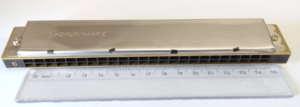Tremolo harmonica facts for kids
A tremolo harmonica is a special type of harmonica. What makes it unique is that it has two reeds for each note you play. Imagine two tiny metal strips that vibrate to make sound. On a tremolo harmonica, these two reeds are tuned just a little bit differently. One reed is slightly higher in pitch, and the other is slightly lower.
When you blow or draw air through the harmonica, both reeds vibrate at the same time. Because they are slightly out of tune, they create a cool, wavering or warbling sound. This sound is called a "tremolo" effect. It's like a gentle shake in the sound.
Harmonicas with a faster, more noticeable wavering sound are called "wet." If the reeds are tuned closer together, the wavering is slower and less obvious. These are called "dry" harmonicas.
Contents
What Makes a Tremolo Harmonica Special?
The word "tremolo" usually means a quick change in how loud a sound is. (Sometimes people confuse it with "vibrato," which is a change in pitch.) Many musical instruments create tremolo by playing a note over and over very fast.
But the tremolo harmonica does it differently. It uses something called "beats." When two sounds that are almost the same pitch play together, they create a pulsing or "beating" effect. On a tremolo harmonica, each note has two reeds that are just a tiny bit out of tune. This makes the sound seem to get louder and softer in a steady rhythm. The pitch stays the same, but the volume changes.
You can find this "beating" sound in other instruments too. Accordions, harmoniums, and some reed organs use similar ideas. Even on a piano, some notes have three strings tuned slightly differently to make a richer sound.
How Tremolo Harmonicas Are Built
Most tremolo harmonicas are made using a design called the "Wiener system." This name comes from Vienna, a city in Austria where these harmonicas first became popular. In this design, the two reeds for each note are on different plates, one on top and one on the bottom. They share a space for air.
Unlike regular ten-hole harmonicas (like the Hohner Marine Band), the reeds for blowing and drawing air don't share the same air space. They are separate. This design lets a player choose to play just one reed if they want to. While most players play both reeds at once for the tremolo sound, being able to play single reeds allows for special effects. For example, you could block one set of reeds with your lips to play without the tremolo effect. However, these tricks are mostly for special sounds; usually, the harmonica is played with both reeds vibrating together.
How Tremolo Harmonicas Are Tuned
Tremolo harmonicas come with a few different ways their notes are laid out. An older way of tuning is much like the standard diatonic harmonica. In this tuning, the main musical scale (like C-D-E-F-G-A-B) is in the middle and upper parts of the harmonica. The lowest part has two chords: one for blowing and one for drawing. This setup is great for playing chords behind simple folk songs.
In parts of Asia, like China and Japan, they often add more notes to this tuning. This helps players play melodies more easily.
A newer tuning, very popular in Asia, is called "scale tuning." This layout is similar to what you find on chromatic harmonicas. With scale tuning, the notes of the main scale are repeated throughout the harmonica. This makes it easier to play full melodies. Sometimes, players in Asia even stack two harmonicas (like a C and a C-sharp harmonica) to get all the notes they need.
Where Tremolo Harmonicas Are Used
Tremolo harmonicas are very common around the world. They are super popular in folk music and in many parts of East Asia. In Western countries, you'll often hear them in traditional folk music across Europe and South America.
But in places like China, Japan, Korea, and Taiwan, tremolo harmonicas are used in almost all kinds of music. This includes folk music and even classical music! There are even special tremolo harmonicas made for playing in musical groups. Sometimes, players will hold several harmonicas at once, one on top of the other. This lets them play notes and chords that aren't available on just one instrument.
Other Types of Tremolo Harmonicas
There are even chromatic tremolo harmonicas! These combine the unique wavering sound of a tremolo harmonica with the slider button found on a chromatic harmonica. The slider lets you play all the sharp and flat notes. A harmonica expert named John Infande has been making his own versions of these for years. More recently, the Japanese company Suzuki Musical Instrument Corporation has also started making its own chromatic tremolo harmonicas.


